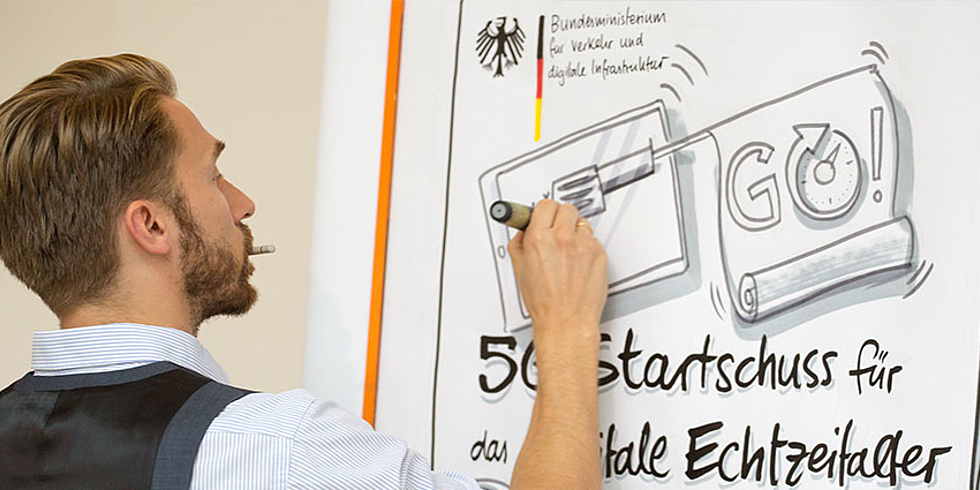5G: What we wish the new super technology to be and what can be realistically expected
5G is a new standard for mobile communications
Not exactly, as this standard is still in development. In an <link http://ec.europa.eu/newsroom/dae/document.cfm?doc_id=17131>action plan</link> the European Commission has pointed out the importance of a coordinated deployment of 5G networks in Europe. Only if Europe can agree on a common standard it will be able to contribute to a global consensus on the best technologies, frequencies, bandwidth and applications, with planned frequency ranges of up to 300 GHz (3.5 GHz are common today). Last summer, <link https://www.bitkom.org/Presse/Presseinformation/Zukunftstechnologie-5G-braucht-neue-Mobilfunkfrequenzen.html>digital association Bitkom</link> said that the designation of new frequency bands is a prerequisite for 5G to be used to its full potential. The assocation calls for a harmonised frequency strategy across Europe. Starting in 2018, the new 5G standard will be implemented in a multi-step process. The truth is: 5G is set to be the new standard in a few years‘ time.
5G is a wireless mobile communications infrastructure
Only the communication between base stations (with its antennas) and end devices will be wireless. However, transmission rates will heavily depend on the technical connection of base stations. If the planned capacities are to be realised, each base station has to be connected <link http://www.lte-anbieter.info/5g/>to the provider’s core network using fibre optic cables</link>. Other important aspects of 5G networks are flexibility and intelligence. These are provided by virtualised network functions (NFV) and network configurations defined by software (SDN). Additional logic in 5G networks close to the end device enable applications with ultra-short response times, for example in the context of autonomous driving.
If this is achieved, 5G will be more than just a mobile communications infrastructure. “5G is an advanced technological overall system with a multitude of collaborating actors,” Fraunhofer HHI and Fraunhofer FOKUS said in <link https://cdn1.scrvt.com/fokus/89b8cea4ef91db33/924003af9d1c/5G-Berlin_Kurzinfo_de_160229.pdf>this analysis</link>. The bottom line is that due to the necessary fibre optic connections and the investments in 5G network components, Germany will face huge infrastructure investments. Once these are done, we will have an intelligent communications infrastructure for a variety of applications and end devices.
5G technology is expected to be market-ready by 2020.
This is the timeframe set by the German government. In its <link http://www.bmvi.de/SharedDocs/DE/Anlage/Digitales/bmvi-initiative-5-schritte-zu-5g.pdf?__blob=publicationFile>5G initiative for Germany,</link> the federal government has put out the objective to provide a German city with the infrastructure necessary to enable 5G networks by 2020. As shown on <link http://www.bmvi.de/DE/DigitalesUndRaumentwicklung/DigitaleInfrastrukturen/5GAktivitaetenInDeutschland_BKG/5G%20Karte/5g-karte_node.html>this map</link> provided by the Federal Ministry of Transport and Digital Infrastructure (BMVI) there are many projects that are currently being developed across Germany with Berlin as a driving force behind 5G. Nonetheless, the advisory website “lte-anbieter.info” points out that <link http://www.lte-anbieter.info/5g/>such forecasts have been a little too optmistic in the past</link> and expects the technology to be ready between 2022 and 2023. However, the tendency is that we will be able to commercially use 5G technology in a few years from now.
5G enables communication in real time
Compared to 4G (LTE) and the upcoming evolution to LTE-Advanced and LTE Advanced Pro, 5G enables a thousandfold higher capacity, a hundredfold higher connection density, tenfold higher speed and tenfold lower latency periods with peak data rates of 10-20 Gbit/s. In addition, 5G guarantees data rates of up to one Gbit/s at every point of the network. Initial trials prove that these numbers are not just fiction but realistic goals. At the <link http://www.lte-anbieter.info/5g/>Mobile World Congress 2015 a 5G trial network set up by Ericsson achieved data rates of up to 3560 MBit/s</link>. With support by and at the initiative of the Senate Department for Economics, Technology and Research, Nokia and Deutsche Telekom during the International Stadium Festival (ISTAF) in Berlin demonstrated a 5G application for a major sporting event under real conditions. Thanks to 5G, the spectators in the stadium were able to virtually experience a live event using 360° goggles. Considering the test results and the low latency periods it is no exaggeration to say that, yes, 5G enables real time communication.
5G will revolutionise our life
The reason why 5G is driven forward so vehemently by research, industry and politics is clear: many innovations cannot be put into practice without 5G. Autonomous driving, e-health, virtual reality and many other applications are based on huge data volumes being communicated in real time between machines (M2M). The bottom line is that it is no myth: as soon as 5G becomes available many applications will be created that will only be possible because of these capacities. These new technologies are indeed set to change our everyday lives.


